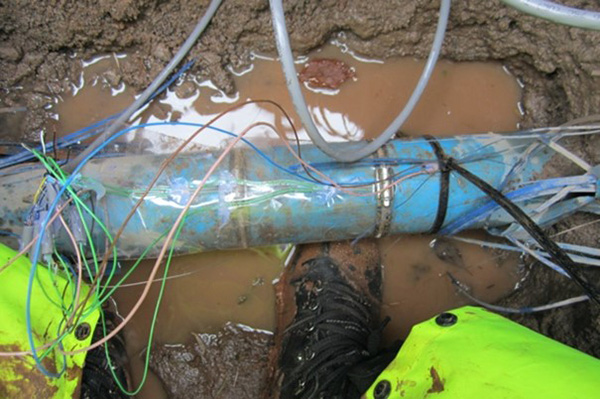Data is becoming increasingly important in today’s world and is vital to drive the Internet of Things and Digital Twinning forward. It further enables the use of Machine Learning. However, our infrastructure is often data poor and this applies in particular to our buried infrastructure and the ground itself. In 1500, Leonardo da Vinci already said we know more about the stars above us than the ground below. This is still true today.
Our work at the University of Birmingham has focussed on developing novel sensors for the subsurface which can provide either more information about the ground or the assets buried in the ground. In addition, we have developed advanced algorithms to obtain more information from data routinely collected by industry.
Our pipes buried in the ground don’t have many sensors attached to them. Often, sensors are only positioned at the end of water treatment works or at the boundaries of district metering areas. This can make detecting leaks challenging as the standard process is to look for abnormal changes in the nightflow. Our Smart Pipes research focussed on developing cheap sensors, distributed along pipelines to detect and localise leaks. This turns our ‘dumb’ pipes to ‘smart’ pipes. We successfully developed a new sensor system based on a force sensitive resistor and demonstrated it in a field trial together with Severn Trent Water. As part of Assessing the Underworld we also successfully demonstrated Time Domain Reflectometers to detect leaks.
 With the increasing use of optical fibres, telecoms companies are replacing their copper cables and also increase the fibre network to ensure fibre to the premise for all. The easiest way of installing new fibres is by using existing conduits as they are already in the ground. However, blocked or broken conduits make the installation process impossible. Thus, we assessed existing sensing technologies together with RSK, BT and Geomatrix in the FINDIT project. Both Ground Penetrating Radar (GPR) and acoustics at the end of the conduit showed potential and the technologies were tested, evaluated and proven in a field trial.
With the increasing use of optical fibres, telecoms companies are replacing their copper cables and also increase the fibre network to ensure fibre to the premise for all. The easiest way of installing new fibres is by using existing conduits as they are already in the ground. However, blocked or broken conduits make the installation process impossible. Thus, we assessed existing sensing technologies together with RSK, BT and Geomatrix in the FINDIT project. Both Ground Penetrating Radar (GPR) and acoustics at the end of the conduit showed potential and the technologies were tested, evaluated and proven in a field trial.
NBIF now enables us to extend this work in a controlled environment.
Useful papers
- Metje, N., Chapman, D., Stringfellow, M., Rebegea, S., Tuckwell, G., Guy, M., Parkin, N., Roberts, D., Leech C., Lord, A. (accepted). Locating blockages in buried (telecoms) ducts: a new approach. Smart Infrastructure and Construction. https://doi.org/10.1680/jsmic.20.00019.
- Sadeghioon, A.M., Metje, N., Chapman, D.N., Anthony, C.J. (2018). Water pipeline failure detection using distributed relative pressure and temperature measurements and anomaly detection algorithms, Urban Water Journal, Vol. 15 (4), pp. 287-295.
- Metje, N., Chapman, D.N., Cheneler, D., Ward, M., Thomas, A.M. (2011). Smart Pipes—Instrumented Water Pipes, Can This Be Made a Reality? Sensors 2011, Special Issue: Collaborative Sensors, 11. pp. 7455 – 7475, doi:10.3390/s110807455.